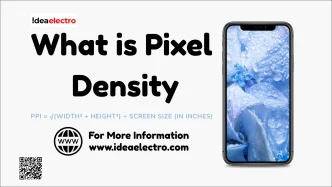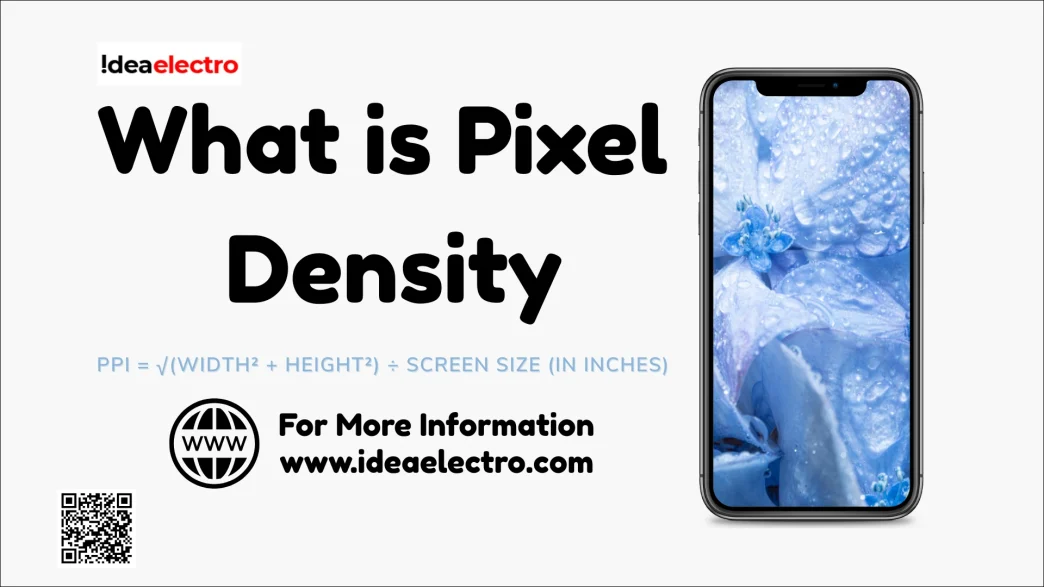Pixel density refers to the concentration of pixels in a given area of a display, typically measured in Pixels Per Inch (PPI). It tells us how tightly packed the pixels are on a screen. A higher PPI results in sharper, more detailed visuals, as the individual pixels are smaller and less distinguishable to the human eye.
It’s important to distinguish pixel density from resolution, which is simply the total number of pixels a screen can display (e.g., 1920×1080, or Full HD). Resolution alone doesn’t determine sharpness; it’s the combination of resolution and screen size that matters. For example, a 1920×1080 resolution on a 5-inch smartphone will look much sharper than the same resolution on a 32-inch monitor because the pixels are spread over a larger area in the latter.
To illustrate, think of filling two jars with beads. A small jar filled with 1,000 beads will look densely packed, while a large jar with the same number of beads will seem sparse. Similarly, pixel density depends on how many pixels are squeezed into a given screen size.
How Pixel Density is Calculated
Pixel density is calculated using a straightforward formula:
PPI = √(width² + height²) ÷ screen size (in inches)
Here, width and height refer to the resolution in pixels, and screen size is the diagonal measurement of the display in inches. The formula calculates the diagonal resolution (using the Pythagorean theorem) and divides it by the diagonal screen size.
Example Calculation
Consider a smartphone with a 5-inch screen and a resolution of 1920×1080:
- Calculate the diagonal resolution:
√(1920² + 1080²) = √(3,686,400 + 1,166,400) = √4,852,800 ≈ 2202.45 pixels. - Divide by the screen size:
2202.45 ÷ 5 ≈ 440.49 PPI.
This means the smartphone has a pixel density of approximately 440 PPI, which is considered very sharp.
For quick calculations, online PPI calculators are widely available. Simply input the resolution and screen size, and they’ll do the math for you.
Why Pixel Density Matters
Pixel density directly impacts the quality of your viewing experience in several ways:
- Sharpness of Text and Images: Higher PPI results in crisper text and more detailed images, making everything from reading emails to viewing photos more enjoyable.
- Viewing Comfort: Low pixel density can make pixels visible, causing a “pixelated” look that strains the eyes. Higher PPI reduces this strain, especially during prolonged use.
- Color Accuracy and Detail: High PPI allows for finer details in high-definition content, such as 4K videos or intricate game graphics, enhancing realism.
- Gaming and VR: In fast-paced gaming or immersive virtual reality, high pixel density ensures smooth visuals and prevents the “screen door effect,” where pixel gaps are noticeable.
Pixel Density in Different Devices
Pixel density requirements vary across devices due to differences in screen size and typical viewing distances:
- Smartphones and Tablets: Flagship smartphones often boast PPI values above 400 (e.g., iPhone 14 Pro at ~460 PPI), delivering razor-sharp visuals. Budget devices may hover around 250–300 PPI, which is still adequate for most users. Tablets, with larger screens, often have slightly lower PPI but remain sharp due to their size.
- Laptops and Monitors: A 15-inch Full HD (1920×1080) laptop typically has a PPI of around 140, which is acceptable but less sharp than a 4K (3840×2160) display at ~294 PPI. High-resolution monitors are ideal for creative professionals needing precise detail.
- TVs: Large TVs, viewed from farther away (e.g., 6–10 feet), don’t require extremely high PPI. A 55-inch 4K TV has a PPI of around 80, which looks sharp at typical viewing distances.
- Virtual Reality Headsets: VR headsets demand exceptionally high PPI (often 600+ PPI) because the screen is inches from the eyes. Lower PPI in VR can cause noticeable pixilation, breaking immersion.
Ideal Pixel Density
Apple popularized the term Retina Display, referring to screens where pixels are indistinguishable at a typical viewing distance (e.g., 10–12 inches for smartphones). This threshold is often cited as around 300 PPI for the average human eye, though it varies based on vision and distance. For example:
- At 12 inches, 300 PPI is sufficient for most people to perceive a “perfect” image.
- Closer distances (like in VR) require higher PPI, while farther distances (like TVs) need less.
However, pushing PPI beyond a certain point yields diminishing returns. For instance, the difference between 400 PPI and 500 PPI on a smartphone may not be noticeable to most users under normal conditions.
Myths and Misconceptions
Several myths surround pixel density:
- “Higher PPI always equals better display”: Not necessarily. Beyond ~300–400 PPI, improvements are subtle unless viewed extremely closely. Other factors like brightness, contrast ratio, refresh rate, and color accuracy often have a bigger impact on perceived quality.
- Marketing Hype: Manufacturers sometimes overhype resolution numbers (e.g., “8K Ultra HD!”) without mentioning that on smaller screens, the benefits of ultra-high PPI are minimal.
- Ignoring Other Factors: A display with high PPI but poor brightness or color calibration will look worse than a balanced, lower-PPI screen.
Future of Pixel Density
Display technology continues to evolve, with trends pointing toward even higher pixel densities:
- 4K and 8K Smartphones: While already available, ultra-high-resolution displays are becoming more common, though their benefits are debated due to battery drain and minimal visible gains.
- Foldable Devices and Wearables: Foldable phones and smartwatches face unique challenges, as flexible screens and small displays require high PPI to maintain clarity.
- Balancing Act: Manufacturers must balance PPI with battery life and processing power, as rendering high-resolution content demands more resources.
Emerging technologies, like micro-LED and advanced OLED, promise to push pixel density further while improving efficiency, potentially transforming devices like AR glasses and compact wearables.








